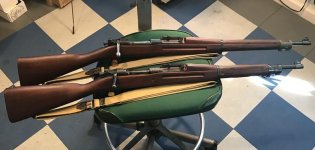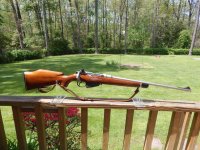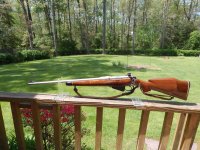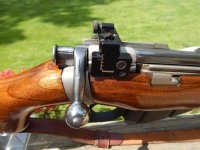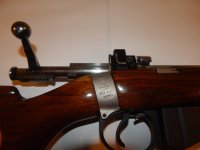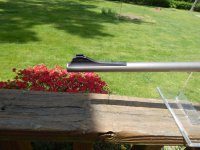You are using an out of date browser. It may not display this or other websites correctly.
You should upgrade or use an alternative browser.
You should upgrade or use an alternative browser.
Wait for M1903 or buy this Enfield?
- Thread starter BabaBlueJay
- Start date
31FordA
Member
$600 for a SMLE is a good price in todays market. I’d say buy it, but I’m a big Lee-Enfield fan. My SMLE is a 1916 production gun that was later transferred to the Irish Free State by the Brit’s during the Irish Civil War. The Irish connection makes it special to me. I also have a WWII vintage #4Mk1 and several post war #4Mk2’s. My favorite version to shoot is the #4Mk2.
I also have a .30’06 Model 1917 Enfield, which is also a great rifle. Mine is a 1918 Eddystone production example. I specifically wanted an Eddystone because one of my grandfathers helped build the plant, and both of my grandfathers worked in the plant during the Great War.
The standard issue rifle for the US Army in France was the Model 1917, not the 1903. The 1917 was produced in much greater numbers, since there were already several plants set up to build them. Only the USMC retained the 1903 for service in France. To have a complete set of American rifles of WWI you would also need a Moisin-Nagant, since the 339th Infantry carried them in Russia during the intervention in 1918/1919.
If you are looking for a M1903 the CMP auction site sometimes has them. They have had several recently, both Springfield and Rock Island examples. Remember that really low serial number 1903’s are not safe to shoot, due to less than ideal heat treatment. .
I also have a .30’06 Model 1917 Enfield, which is also a great rifle. Mine is a 1918 Eddystone production example. I specifically wanted an Eddystone because one of my grandfathers helped build the plant, and both of my grandfathers worked in the plant during the Great War.
The standard issue rifle for the US Army in France was the Model 1917, not the 1903. The 1917 was produced in much greater numbers, since there were already several plants set up to build them. Only the USMC retained the 1903 for service in France. To have a complete set of American rifles of WWI you would also need a Moisin-Nagant, since the 339th Infantry carried them in Russia during the intervention in 1918/1919.
If you are looking for a M1903 the CMP auction site sometimes has them. They have had several recently, both Springfield and Rock Island examples. Remember that really low serial number 1903’s are not safe to shoot, due to less than ideal heat treatment. .
Keep in mind that just because a firearm may have been made in the war years, it may or may not have seen any action. All original WW1 firearms are rare and priced as such. Most went through referb at least once.
If you want a WW! era rifle that more than likely seen action get a Finnish capture American made Remington and/or New England Westinghouse M1891 Mosin Nagant. Those have an interesting history.
If you want a WW! era rifle that more than likely seen action get a Finnish capture American made Remington and/or New England Westinghouse M1891 Mosin Nagant. Those have an interesting history.
$600 for a SMLE is a good price in todays market. I’d say buy it, but I’m a big Lee-Enfield fan. My SMLE is a 1916 production gun that was later transferred to the Irish Free State by the Brit’s during the Irish Civil War. The Irish connection makes it special to me. I also have a WWII vintage #4Mk1 and several post war #4Mk2’s. My favorite version to shoot is the #4Mk2.
I also have a .30’06 Model 1917 Enfield, which is also a great rifle. Mine is a 1918 Eddystone production example. I specifically wanted an Eddystone because one of my grandfathers helped build the plant, and both of my grandfathers worked in the plant during the Great War.
The standard issue rifle for the US Army in France was the Model 1917, not the 1903. The 1917 was produced in much greater numbers, since there were already several plants set up to build them. Only the USMC retained the 1903 for service in France. To have a complete set of American rifles of WWI you would also need a Moisin-Nagant, since the 339th Infantry carried them in Russia during the intervention in 1918/1919.
If you are looking for a M1903 the CMP auction site sometimes has them. They have had several recently, both Springfield and Rock Island examples. Remember that really low serial number 1903’s are not safe to shoot, due to less than ideal heat treatment. .
I'm Irish too so it would be epic if this one has a similar tale. For 550$ in good condition I might just get it. Worst case I can trade it later for a 1903. I'm going to get a closer look tomorrow and make a decision sometime this week.
Baltimoreed11754
Member
I have two 1903s, ones a 1919 Mk1 Pederson, a No1 MkIII Enfield and a 1917. All were sporters that I put back military. I enjoyed the ‘03 builds better than the other two. Didn’t like the long Enfield and 1917 as they are very barrel heavy. Also found out that I prefer cock on opening bolts. The two ‘03s are my favorite milsurps after my Krags. Good luck on your hunt.
Attachments
Last edited:
Glenn R. McMannly
Member
Springer. Easy.
dsf
Member
I googled images of p14 vs SMLE and I'm pretty sure based on the image the one at my shope IS SMLE

Bc it has the magazine and the barrel doesn't stick out the front. It looks almost exactly like the top one in this image
There are many variations of the Enfield. The No4 Mk1 and No4 Mk II are often seen.
This is a cobbled together "sniper" version made back when the Irish guns were cheap.

The No4s carry an aperture rear sight on the receiver rather than the ladder type on the barrel.
Last edited:
I got my second 1917 cal.30-06 almost 50 years ago. Still have it. I picked up a 1903 about 20 years ago from a guy that brought it back from the war. Frankly I like the 1917 better and I gave the 03 to #1son. Some people do not like the cocking on the downward stroke, but it is fine by me.
LVSteve
Member
Once the magazine is set up correctly, the SMLE is about as slick as you can go with a bolt gun.
I suggest some of you brace yourselves now as I'm about to reduce some sacred milsurp cows to hamburger. When it comes to shooting milsurps, the biggest factor you will notice is the effectiveness (or not) sights. My observations.
Mauser 95s and 98s. I don't know who designed these sights, but I doubt he/she ever actually tried shooting them in realistic conditions. The barleycorn front sight combined with the very shallow notch in the rear, barrel mounted, sight are simply awful in tricky light. In certain light it's almost like the front sight moves. Maybe it's me, but look at the sight picture of a 98, then pick up a Swede 96. The Swede has vastly superior sights.
SMLE. The straight-sided front sight is great, but again the rear sight notch is very shallow and difficult to pick up quickly. Negates some of the advantage of the slick bolt, I reckon.
Springfield 1903. I only have an 03A3, not a WWI veteran. The receiver peep on 03A3 is great, but the very thin front sight is difficult to pick up when the background is cluttered (real world) but fine on the range. What is that thing about the Springfield being the best target rifle? The bolt on my 03A3 is very slick, almost as good as an SMLE.
The bolt on my 03A3 is very slick, almost as good as an SMLE.
Carcano. Yes, seriously. The front sight is almost straight-sided, and it has a deep and wide rear V notch for quick acquisition. It works well for me, but I've read grumbles that the sights limit ultimate accuracy. How much of that is truth, down to poor ammo, or a "not invented here" attitude to the sight picture I cannot say. The sticky action of the Mannlicher bolt spoils the Carcano somewhat. Even my almost unused M1941 requires a little wrestling compared to a Mauser.
Mosin Nagant. Problem here is "which model". Nearly all the M91 rifles we see here have a Mauserish front sight and a rear sight with a fairly sizeable V notch. Sight picture is so-so. The early 91/30 rifles have a front post and a rear sight with a reasonably sized U notch. They work well. Unfortunately, when WWII got going, the Soviets started using a Mausereque shallow rear V notch, probably because it was quicker to produce. It's hopeless in poor light. Mosin bolts vary greatly in smoothness. Mid WWII Soviet rifles can be as obstructive as a bad Carcano. A Finnish modified gun can be very slick.
Berthier. Huge, wide front sight. It should say "Oversize Load" on the back. The rear sight is set up to match. Camp Perry boys from the '20s would have a fit of the vapors at the sight of one. It's a combat sight, plain and simple. You put the target in the middle of the sight, a complete reversal to the US philosophy. THis guy explains it better than me. Perspectives on French Rifle Sight Design The Berthier bolt is a bit clunky. If you think it feels large, that's because it is. The French 8mm round has a bigger case head than 30-06 or 8mm Mauser, so the bolt is chunkier.
Enfield P14/US Model of 1917. Brilliant sights. Nothing to add on those. Biggest issue with the bolt is that people screw with them by fitting a kit that changes the operation to cock-on-opening from the original cock-on-closing. Vandals. Either way, they are nowhere near as slick as a SMLE. The Winchester P14s can be ammo finicky, as it seems that Winchester had their own ideas on the precise geometry of certain areas of the receiver. Many P14 parts are not interchangeable between the ERA and Remington rifles, and those made by Winchester. I think that issue was fixed on the M1917.
Enfield No.4 Mk1 and derivatives. The rifles with the vernier rear sights are great. The peep is a nice size, and the vertical adjustment fine enough for accurate fire. The two position 300/600 yard flip sight is OK for the intended purpose in wartime.
I suggest some of you brace yourselves now as I'm about to reduce some sacred milsurp cows to hamburger. When it comes to shooting milsurps, the biggest factor you will notice is the effectiveness (or not) sights. My observations.
Mauser 95s and 98s. I don't know who designed these sights, but I doubt he/she ever actually tried shooting them in realistic conditions. The barleycorn front sight combined with the very shallow notch in the rear, barrel mounted, sight are simply awful in tricky light. In certain light it's almost like the front sight moves. Maybe it's me, but look at the sight picture of a 98, then pick up a Swede 96. The Swede has vastly superior sights.
SMLE. The straight-sided front sight is great, but again the rear sight notch is very shallow and difficult to pick up quickly. Negates some of the advantage of the slick bolt, I reckon.
Springfield 1903. I only have an 03A3, not a WWI veteran. The receiver peep on 03A3 is great, but the very thin front sight is difficult to pick up when the background is cluttered (real world) but fine on the range. What is that thing about the Springfield being the best target rifle?
Carcano. Yes, seriously. The front sight is almost straight-sided, and it has a deep and wide rear V notch for quick acquisition. It works well for me, but I've read grumbles that the sights limit ultimate accuracy. How much of that is truth, down to poor ammo, or a "not invented here" attitude to the sight picture I cannot say. The sticky action of the Mannlicher bolt spoils the Carcano somewhat. Even my almost unused M1941 requires a little wrestling compared to a Mauser.
Mosin Nagant. Problem here is "which model". Nearly all the M91 rifles we see here have a Mauserish front sight and a rear sight with a fairly sizeable V notch. Sight picture is so-so. The early 91/30 rifles have a front post and a rear sight with a reasonably sized U notch. They work well. Unfortunately, when WWII got going, the Soviets started using a Mausereque shallow rear V notch, probably because it was quicker to produce. It's hopeless in poor light. Mosin bolts vary greatly in smoothness. Mid WWII Soviet rifles can be as obstructive as a bad Carcano. A Finnish modified gun can be very slick.
Berthier. Huge, wide front sight. It should say "Oversize Load" on the back. The rear sight is set up to match. Camp Perry boys from the '20s would have a fit of the vapors at the sight of one. It's a combat sight, plain and simple. You put the target in the middle of the sight, a complete reversal to the US philosophy. THis guy explains it better than me. Perspectives on French Rifle Sight Design The Berthier bolt is a bit clunky. If you think it feels large, that's because it is. The French 8mm round has a bigger case head than 30-06 or 8mm Mauser, so the bolt is chunkier.
Enfield P14/US Model of 1917. Brilliant sights. Nothing to add on those. Biggest issue with the bolt is that people screw with them by fitting a kit that changes the operation to cock-on-opening from the original cock-on-closing. Vandals. Either way, they are nowhere near as slick as a SMLE. The Winchester P14s can be ammo finicky, as it seems that Winchester had their own ideas on the precise geometry of certain areas of the receiver. Many P14 parts are not interchangeable between the ERA and Remington rifles, and those made by Winchester. I think that issue was fixed on the M1917.
Enfield No.4 Mk1 and derivatives. The rifles with the vernier rear sights are great. The peep is a nice size, and the vertical adjustment fine enough for accurate fire. The two position 300/600 yard flip sight is OK for the intended purpose in wartime.
Last edited:
LVSteve
Member
Were any Enfield made in 1916 made in England and if so how could I know? Would there be a mark or something.
If you can see "1916" on the outside of the gun, it's an SMLE. Where it was built can only be determined byother marks. The date of a Pattern 14 (P14) can only be found by removing the handguard to read a date on the barrel.
Darkenfast
Member
I think it's a hoot that the 1917 in 30-06 still serves in Greenland with Denmark's Sirius Patrol, backed up by Glock Model 20 10mm autos!
I've got one signed by George Rex hisself!
Yessiree, can't beat an old 303 battle rifle, sporterized by that great American gunsmithing company, Sears Roebuck & Co. in 1962.

Cost was $45.00 (delivered by rail to the local train station) in 1962 dollars, ammo was dirt cheap, not so much now days.
This rifle has seen plenty field action in Northwestern PA in the good ole days. Now sits neglected in my safe except for an outdoor range day and even then the M1 Garand seems to be more popular with my crowd.
Yessiree, can't beat an old 303 battle rifle, sporterized by that great American gunsmithing company, Sears Roebuck & Co. in 1962.
Cost was $45.00 (delivered by rail to the local train station) in 1962 dollars, ammo was dirt cheap, not so much now days.
This rifle has seen plenty field action in Northwestern PA in the good ole days. Now sits neglected in my safe except for an outdoor range day and even then the M1 Garand seems to be more popular with my crowd.
Attachments
AJ
US Veteran
A 1916 dated SMLE would probably made the trip across the Channel at least once. It could have been involved in the second go around also. The Brits were using anything and everything to defend themselves after Dunkirk.
I decided against it. I'll hold out for the gun I really want.
GypsmJim
Member
- Joined
- Oct 16, 2009
- Messages
- 3,997
- Reaction score
- 6,930
You are correct that I'm more interested in the M1903 because I am an American History teacher. The rifle I'm looking at is a Lee Enfield made in 1916 not 1917. In this thread people keep referring to it as a p14 but I saw no such markings on it and it's being sold as an Enfield in 303 British. I'll have to do more digging to find out if it's American or British made.
THAT changes the whole perspective. WAIT for what you want. I assume you aren't going to shoot it, but rather S&T it to your students. Thus, ammo availability or cost is of no concern.
smoothshooter
Member
Check the bore carefully. Most are severely pitted from being fired with ammo with corrosive primers and not PROPERLY cleaned afterward. A lot of them had good bores while they were an item of issue, but long after being sold off as surplus ignorant shooters were able to buy military surplus ammo cheaply and fired away, not knowing or caring that careful cleaning within hours of shooting the corrosive surplus ammo was required. Conventional oils will not do the job. The old military rifle bore solvent, or at least soapy water was needed to get the corrosive salts out of the bore, followed by a couple of oily patches after the water was gone.
Any cleaner ( including home-made ) that works well on black powder fouling will do a fine job on the old corrosive military ammo mercuric salts.
FWIW, all military smokeless powder small arms ammunition used corrosive primers until well into the 1950’s. First, because it was all they had, and second because the corrosive primers were believed to remain reliable for more years than the newer non-corrosive primers when they became available sometime before WWII.
The only exception to the above that I know of was .30 Carbine ammo. It was only loaded with non-corrosive primers from the beginning, which was around 1938 or so.
Some corrosive surplus Chinese M-1 Carbine ammo loaded sometime around the Korean War or a little later showed up on the surplus market 25-30 years ago, but I am not aware that there was very much of it around, and heard or read very little about it.
Any cleaner ( including home-made ) that works well on black powder fouling will do a fine job on the old corrosive military ammo mercuric salts.
FWIW, all military smokeless powder small arms ammunition used corrosive primers until well into the 1950’s. First, because it was all they had, and second because the corrosive primers were believed to remain reliable for more years than the newer non-corrosive primers when they became available sometime before WWII.
The only exception to the above that I know of was .30 Carbine ammo. It was only loaded with non-corrosive primers from the beginning, which was around 1938 or so.
Some corrosive surplus Chinese M-1 Carbine ammo loaded sometime around the Korean War or a little later showed up on the surplus market 25-30 years ago, but I am not aware that there was very much of it around, and heard or read very little about it.
Last edited:
AJ
US Veteran
CMP has two M1903's up for auction now. Guns on Auction - Civilian Marksmanship Program Your neck of the woods too.
31FordA
Member
I'm Irish too so it would be epic if this one has a similar tale. For 550$ in good condition I might just get it. Worst case I can trade it later for a 1903. I'm going to get a closer look tomorrow and make a decision sometime this week.
The Irish Civil War guns have the original serial number struck out and a new serial number placed above the original. The Brits did that to make it harder for sympathetic officials in the Free State gov’t to pass on the rifles to the IRA in Ulster. There are a bunch of them floating around over here since Ireland sold off all the surviving rifles to US importers in the 80’s and 90’s.
There’s a world of difference between the 03 sight and the 03A3 rear sight. I enjoy shooting the 03a3 more, cause the sights are easier on my eyes. I also installed a “marine” front sight on it. That all being said, the 03 built its “target” reputation based on being compared to other mil rifles of the day, any it was more adjustable than other sights.
Thanks Noonster. I didn’t know of that option and the skinny front sight always bothered me on my 1903a3. I just ordered one.
1903 A3 Springfield USMC #10 Front Sight Blade Reproduction Made in U.S.A.
1903 A3 Springfield USMC #10 Front Sight Blade Reproduction Made in U.S.A.
Similar threads
- Replies
- 9
- Views
- 2K
- Replies
- 17
- Views
- 757
- Poll
- Replies
- 97
- Views
- 5K
- Replies
- 45
- Views
- 1K
- Replies
- 19
- Views
- 961


